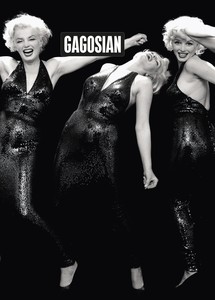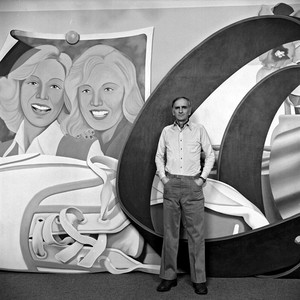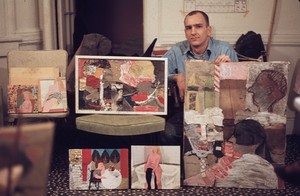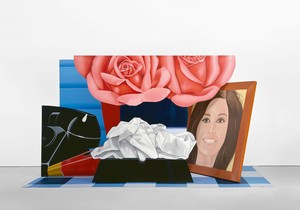
Now available
Gagosian Quarterly Summer 2023
The Summer 2023 issue of Gagosian Quarterly is now available, featuring Richard Avedon’s Marilyn Monroe, actor, New York, May 6, 1957 on its cover.
The prime mission of my art . . . is to make figurative art as exciting as abstract art.
—Tom Wesselmann
Tom Wesselmann (1931–2004) was one of the leading American Pop artists of the 1960s. Departing from Abstract Expressionism, he explored classical representations of the nude, still life, and landscape, while incorporating everyday objects and advertising ephemera.
Wesselmann was drafted into the US Army in 1952, two years into the Korean War. During his military service, he learned—then taught—aerial photography interpretation, and began to draw cartoons about his experiences. Upon his return to his hometown of Cincinnati, he completed a BA in psychology at the University of Cincinnati and began taking classes at the Art Academy of Cincinnati. In fall 1956, he moved to New York City to study art at the Cooper Union for the Advancement of Science and Art, where the artist Nicholas Marsicano was one of his instructors. At Cooper Union, he met Claire Selley, who would become his wife and lifelong muse. Wesselmann’s early drawings of Selley often took the form of hybrid collages, incorporating sketches, scraps of wallpaper, and found advertisements. Similarly, his early assemblage paintings, which include functioning objects and gadgets, present shifting images that advance and retreat depending on the viewer’s relative position.
Living in Brooklyn, Wesselmann supported himself by selling cartoons to the Saturday Evening Post, “gag” magazines, and advertising agencies. In the late 1950s, he cofounded the Judson Gallery in the West Village with Marc Ratliff and Jim Dine. After completing his studies at Cooper Union, Wesselmann spent three years teaching high school art and math. During the evening, he continued to expand his own artistic practice, making small portrait collages, such as his groundbreaking Portrait Collage #1 (1959). Wesselmann recalled: “I wanted my painting to be spatially and visually aggressive like de Kooning. But in order to be myself, I knew I had to forget de Kooning, just as he got around Picasso.”
Wesselmann is highly regarded for his Great American Nude series (1961–73), which combines sensual depictions of the female figure with references to art history and popular culture. Many of these lounging female subjects were painted in patriotic red, white, and blue, quoting the Western figurative tradition while incorporating elements of high voltage American advertising. In the late 1960s Wesselmann created close-up views of the nude in the Bedroom Paintings (1968–83). In these works a single part of the body, such as a hand or a breast, is juxtaposed with objects common to the bedroom—a light switch, flowers, the edges of pillows, and curtains.
From 1967 through 1981 Wesselmann worked on his Standing Still Life paintings, monumental works comprising multiple canvases shaped according to the outline of the commonplace objects that they depict; in 2018 the complete series of nine works was exhibited for the first time at Gagosian on West 24th Street, New York. After the Standing Still Lifes, Wesselmann continued to make three-dimensional sculptural work. He also developed an innovative technique of “drawing” with sculptural materials, cutting steel and aluminum in the shape of his drawn forms. His abstract works of the mid-1990s, through the early 2000s expanded this mode of working on a larger scale, and continued to push the boundaries between painting and sculpture.


The Summer 2023 issue of Gagosian Quarterly is now available, featuring Richard Avedon’s Marilyn Monroe, actor, New York, May 6, 1957 on its cover.

Susan Davidson, editor of the forthcoming monograph on the Great American Nudes, a series of works by Tom Wesselmann, explores the artist’s early experiments with collage, tracing their development from humble beginnings to the iconic series of paintings.
On the occasion of the exhibition Tom Wesselmann: Intimate Spaces at Gagosian, Beverly Hills, Susan Davidson sat down with Jeffrey Sturges to discuss the artist’s key works in his Great American Nudes (1961–73) and subsequent series.

Michael Craig-Martin and Jeffrey Sturges in conversation on Tom Wessselmann’s Standing Still Lifes.

Tom Wesselmann: Standing Still Lifes closes this week at Gagosian New York. In this text, Richard Phillips speaks with Jason Ysenburg about the impact of the exhibition. A video about the exhibition and the artist’s studio practice accompanies the text.
Join us for a look at Tom Wesselmann’s New York studio in this behind-the-scenes video. Featuring archival footage of Wesselmann at work, as well as new interviews with his family, studio team, and friends, the film documents the creative process behind his large-scale works, from early still lifes to later abstractions.

The story behind Tom Wesselmann’s Still Life #59 (1972). Text by Lauren Mahony.

Modern master Henri Matisse was a touchstone for American Pop artist Tom Wesselmann throughout his career.

A 1964 publication by the Chinese-American artist and poet Walasse Ting and Abstract Expressionist painter Sam Francis.
Request more information about
Tom Wesselmann